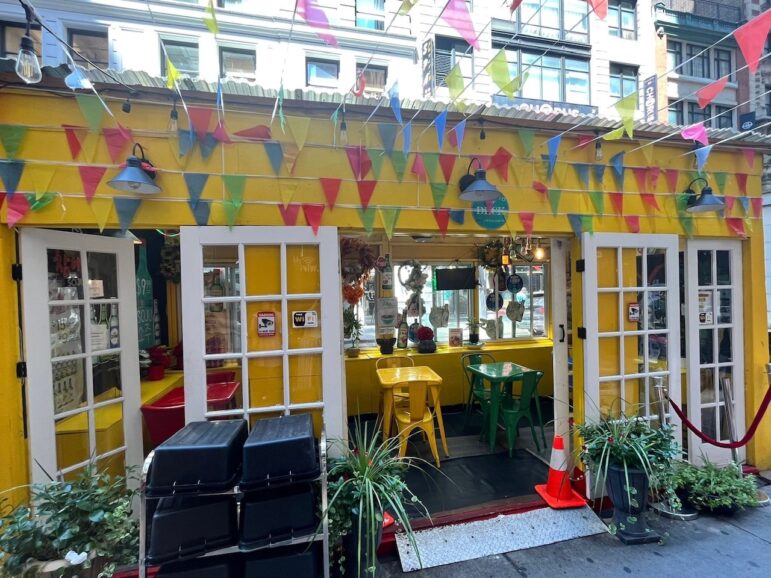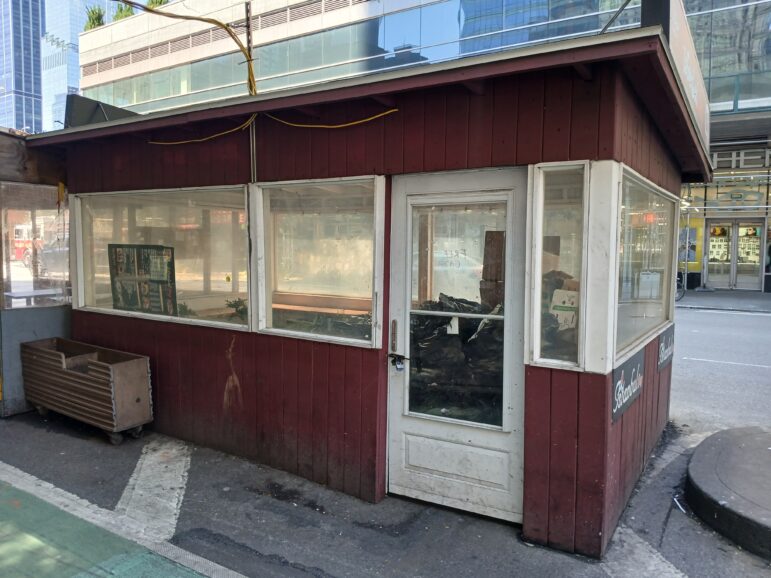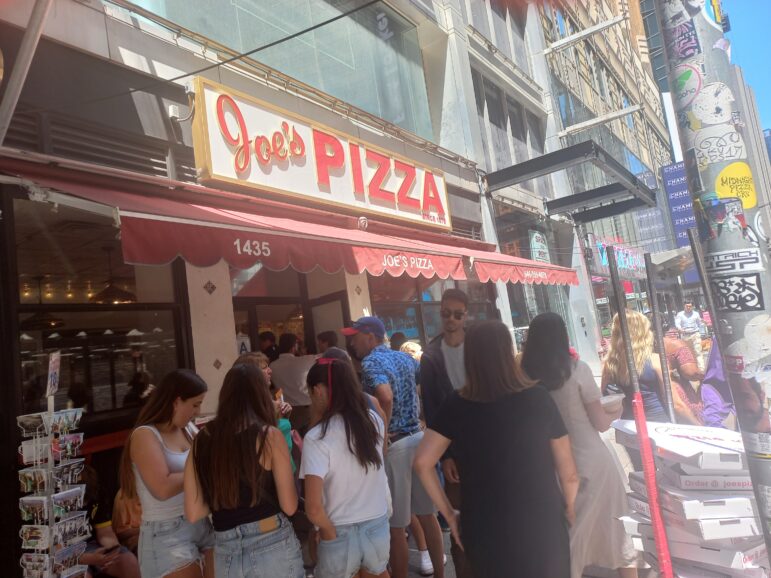The city’s Dining Out NYC program creates new rules restaurants must follow when offering sidewalk or roadway seating, which go into effect Aug. 3. CLARIFY News’ student reporters spoke to restaurant owners and employees near Midtown about their outdoor dining setups.

Jayleen Torres
The manager of Shanghai Mong, an Asian fusion restaurant located in the heart of Manhattan’s Koreatown, said that their outdoor dining structure is important for business.This story was produced by student reporters in City Limits’ CLARIFY News program.
Shanghai Mong, an Asian fusion restaurant located in the heart of Manhattan’s Koreatown, stands out to customers with the visual feast that is its roadway cafe—with bright yellow walls, colorful flags that hang over the sidewalk, and K-pop stickers lining the inside.
With four walls and a roof, the shed is important to attracting customers, said restaurant manager Sue Yi. But now the eatery, located at Broadway and 32nd Street, needs to hire an architect to completely remodel the structure.
The Department of Transportation’s (DOT) new Dining Out NYC program creates new rules restaurants must follow when offering outdoor dining, including complying with a consistent look across the five boroughs, disassembling outdoor dining sheds between November and April, and paying fees to the city. Fully enclosed sheds, like the one at Shanghai Mong, will be banned.
The rules go into effect on Aug. 3, and have sparked controversy from restaurateurs and customers alike who worry they’ll force some eateries to give up their seats outside. On the other side of the aisle, the policy is facing backlash from critics who are upset it will cement outdoor dining structures as more permanent fixtures in the city.
Outdoor sheds like the one at Shanghai Mong will no longer meet DOT regulations because they are fully enclosed and are walled too high.
“I think our shed stands out from the other sheds because it’s so bright and colorful. On top of that, a lot of people who come to K-town have been getting into K-pop, so when they see their favorite K-pop star on the walls, they usually want to take pictures,” Yi said. “If we do a completely different design, I don’t know if people would recognize it.”
Restaurants and cafes can now apply for a four-year license at a flat rate of $1,050 for a roadway or sidewalk cafe, or $2,100 for both. In addition, eateries will need to pay annual revocable consent fees in each year of the four-year term, based on the location and size of the establishment.
Annual payments can vary, from $6 to $31 per sidewalk and/or roadway square foot, based on the area of the outdoor dining setup and the neighborhood in which it is located. The cost is higher for establishments in Midtown Manhattan and less expensive in the outer boroughs. A security deposit—$1,500 for an unenclosed sidewalk cafe and/or $2,500 for a roadway cafe—is also required. Restaurants must also pay a public hearing fee capped at $1,000.
“Outdoor dining enhances our communities, and we’re excited to make it a permanent feature of New York City streets,” said NYC DOT Commissioner Ydanis Rodriguez in a press release statement on July 8. “The city’s new outdoor dining program is the biggest and best in America and we have made it easy to participate through our online application portal and additional resources and guidance available.”
Outdoor dining sheds became a staple during the pandemic, when regulations limited indoor dining options. Restaurants turned to outdoor seating as a way to still serve customers.
Although regulations prohibiting indoor dining have elapsed, outdoor set-ups remain a common feature of many restaurants across the city, with owners saying the additional space allows them to serve more customers and make more money.
While some outdoor dining proponents and restaurant owners are concerned that the new regulations will limit their options, others would rather see the sheds come down.
Leslie Clark, an organizer with the Coalition for Equitable Urban Policy—an alliance of block associations and community organizations—went as far as filing a lawsuit against the city, urging it to conduct an environmental impact review of the policy.
When she noticed outdoor dining setups mushroom throughout her neighborhood in the West Village, garbage and rats came with it, she said. “That has a tremendous impact on people’s life in terms of noise, in terms of congestion on the sidewalks, in terms of rats, in terms of the additional garbage,” Clark said.
“The city gave away the use of public property to a private industry that it has failed to regulate,” she added. “Would you think differently about it if you looked out there and there were nail salons all over your sidewalk? Would you think, what are these nail salons doing out here?”
But others say outdoor dining infrastructure enhances their enjoyment of the city. Roman Schumacher, a tourist from France, said he prefers sitting outside.
“We’re in a big city, so we want to see people passing by,” Schumacher said. “It feels like the city is alive. Being surrounded by the hustle of urban life gives us a sense of energy and connection to the city around us.”
CLARIFY News interns spent a mid-July afternoon interviewing restaurant owners and employees near Midtown about their outdoor dining setups. Here are their stories.
Dim Sum Palace
334 W. 46th St. (8th Avenue and 46th Street)
Kevin Yan, the manager at Dim Sum Palace, says he’s indifferent to whether he has to leave up or tear down their outdoor dining structure. He’s unsure what the cost of renovations to comply with the new DOT standards would be.
He also thinks that many sheds are losing their purpose, noticing that some are either locked shut or being used to store trash. “Taking it down is better,” said Yan. “[If] they say take it down, no problem.”

Erica Tillman
An abandoned outdoor dining shed in Hell’s Kitchen.Pera Mediterranean Brasserie
303 Madison Ave. (Madison Avenue and 41st Street)
Nikki Parlo, 22, a hostess at Pera Mediterranean Brasserie, wasn’t clear if the eatery would apply for outdoor seating, due to not knowing much about the new rules. However, she said she believes losing their current outdoor dining space wouldn’t make much of an impact on business.
“I dont think it’s a bad thing to have outdoor dining, but I also don’t think it’s necessary,” said Parlo. “I think that especially here if you don’t have a reservation and we don’t have a table, we are going to offer you the outside dining. But people make reservations outside and always want to move inside.”
Backstage Tavern
346 W. 46th St. (9th Avenue and West 46th Street)
Murphy Fitzpatrick, a manager at Backstage Tavern, said he understands and accepts the expectations given by the DOT.
“Thankfully the city didn’t initially charge for the outdoor seating in the beginning, [during COVID] but it kind of makes sense they would monetize on it now,” said Fitzpatrick. “I think for us it would kind of make sense to pay for it.”

Naheema Olatidoye
A crowd gathers in front of Joe’s Pizza in Midtown.Joe’s Pizza
1435 Broadway (Broadway and 40th Street)
During a recent visit to Joe’s Pizza, customers enjoyed eating slices standing up under the outdoor dining shed, which provides respite from the sun or rain, but doesn’t include seating. Often, dozens of empty pizza boxes sit piled up outside the establishment.
“The warm weather draws them outside because of the fresh air and lively atmosphere. It’s a big part of their dining experience,” said Prakash Vithaneg, assistant manager.
Bird and Branch
359 W. 45th St. (9th Avenue and 45th Street)
Abby Williams, barista at Bird & Branch, said outdoor dining at the small cafe serves as an extension of the business, allowing more space for customers. However, she doesn’t know what her manager is planning around the incoming requirements.
“It makes our spaces so much more lively and comfortable,” said Williams. “It benefited the cafe a lot, it served more and housed more.”

Maya Wierciszewski
Customers gather outside Bird and Branch to enjoy a coffee.Osteria DelBianco
18 E. 41st St.(Madison Avenue and 41st Street)
Joe Rya, 60, the current manager of Osteria DelBianco, said he isn’t sure if he’ll apply for outdoor dining because of problems from a train line running underneath the establishment. According to DOT requirements, structures must be 15 feet or more away from a subway stair entrance.
“If I was to apply for outdoor dining, who would I inform of the subway problem?” said Rya.
Planet Taco
705 W. 48th St. (9th Avenue and 48th Street)
Sophia Rivera, a manager from Planet Taco, said she is leaning more toward applying for the new program. “The program would affect my business in a positive way,” said Rivera. “There’s more outdoor dining space and we would get more people coming outside.”
Bocca Di Bacco
635 W. 45th St. (9th Avenue and 45th Street)
Roman Meija, host at Bocca Di Bacco, said the restaurant’s owners are considering signing up for the new DOT system to treat it as a “trial year,” to see if they would like to keep doing it in the future.
“Our boss said we’re going to keep it for this year, so we can see if we want to keep it for the next ones,” said Mejia.
With reporting by: Andrew Vera, Cesar Jimenez, Suhani Cuenot, Allen Mantilla, Jovanna Wu, Chloe Zi Ching Wong, Namarachi Okwuka, Mannat Kaur, Mujtaba Raja, Emmanuel Brown, Duncan Park, Subrina Singh, Melanie Gonzalez, Pierce Malter, Jayleen Torres, Ean Bermudez, Haja Ceesay, Anyeli Clemente, Saniyah Davis, Deanna Hayward, Dylan Hernandez-Abreu, Fatima Konneh, Giana Newball, Naheema Olatidoye, Akeelah Outland, Ginger Roger, Paww Susannah Scott, Erica Tillman, and Maya Wierciszewski.
To reach the editor, contact Jeanmarie@citylimits.flywheelstaging.com
Want to republish this story? Find City Limits’ reprint policy here.








